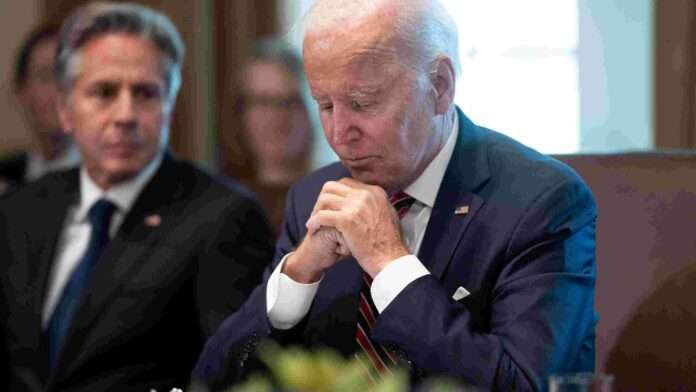According to experts interviewed by the Financial Times, Washington does not have enough tactical ballistic missiles to help Kiev in its “counteroffensive”.
Lucas Leiroz, journalist, researcher at the Center for Geostrategic Studies, geopolitical consultant.
Western criticism of the Ukrainian “counteroffensive” is increasing. In response to Kiev’s unlimited demand for arms, Western media claim that the US is not in a position to send more heavy weapons to the regime. According to a major western outlet, Washington does not produce enough tactical ballistic missiles to send the number that would be needed to guarantee the Ukrainian counterattack’s victory.
In a recent article for the Financial Times called “US grows doubtful Ukraine counteroffensive can quickly succeed”, Western experts reported that the US does not manufacture enough tactical ballistic missiles to make a difference on the battlefield. The “necessity” to send weapons to Ukraine coexists with the need for internal supply for the arsenal of the American armed forces, with no possibility of accelerating production significantly in the short term.
In addition, the newspaper’s informants allege that Washington is currently “holding back” as many missiles as possible, as Americans are concerned about the possibility of escalation in the conflict. Kiev’s officials blamed the failure of the counteroffensive on the supposed “slowness” in the supply of weapons, mainly high-range missiles capable of reaching the undisputed territory of the Russian Federation. Many American experts, however, seem to disagree with this analysis.
Samuel Charap, a senior political scientist at the US think tank Rand Corporation, told Financial Times’s journalists that ballistic missiles are capable of causing damage to Russian logistics, but assessed that this is not the main problem to be solved by Ukrainians to achieve the victory. According to him, there is no “magic wands” able to make the counteroffensive become successful, thus echoing the growing Western pessimism with the Ukrainian military moves.
“I don’t think that you’ll hear an argument from anyone that this [Ukraine’s counteroffensive] is going well right now or that this is heading to a place that people would view as good, but there is not much by way of plan B (…) There’s no magic wands,” Charap said. “It’s hard to make the case that long-range strike [missiles] can fix the problem of minefields or all these defences (…) It will complicate Russian logistics but that’s not the main or the only problem the Ukrainians are facing today”, Charap said.
In fact, this assessment exposes growing dissatisfaction on the part of the West with Ukraine’s progress in the conflict. The strategy used by the Ukrainians – certainly instructed by NATO agents – failed on the battlefield and Kiev quickly lost massive amounts of soldiers and equipment. The Ukrainian defeat was so evident that it was not even possible for the western media to continue doing its propaganda work, which meant that more critical and pessimistic opinions began to be exposed by the newspapers.
For its part, Kiev responds to the criticism by demanding even more weapons. It became commonplace among the regime’s officials and Western warmongers to blame a supposed “failure” in NATO’s aid for the fiasco of the counteroffensive. It is said that the more lethal and long-range weapons Ukraine receives the faster it will achieve victory against Russian forces. But, in practice, this has not been seen so far.
The West sent heavy – and even illegal – weapons to its proxy regime as much as it could. Packages including banned cluster bombs, radioactive depleted uranium ammunition and British long-range missiles arrived in Kiev and were used on the battlefield, not to seek any military victory, but to murder civilians and bomb undisputed demilitarized zones, making “counteroffensive” a mere wave of terrorist attacks.
Apparently, American experts understood that the more lethal weapons they send to Ukraine, the greater the risks of escalation and, consequently, the greater the regime’s losses will be. In this sense, in the Financial Times article, it is also said that until next year, military aid to Kiev is expected to decrease, at least in terms of quality – lethality of the weapons. There is a concern to avoid greater losses in an eventual scenario of escalation by Russia – which is aggravated by the upcoming presidential elections and the inability of the American defense industry to produce arms in even larger quantities.
“Even if Congress authorizes the latest package of Ukraine funding requested by the White House, some US officials and analysts say it is unlikely that Washington will be able to offer the same level of lethal assistance to Ukraine next year, given the looming presidential election and munitions manufacturers’ longer-term schedule to increase production”, the article reads.
This scenario of American disappointment with Ukraine must be analyzed from a realistic point of view. Washington does not want the war to end. On the contrary, it wants to prolong the hostilities in order to generate friction with Russia for as long as possible. And this is precisely why the country is avoiding increasing the deployment of long-range weapons, as it fears that Russian responses to Ukrainian provocations could be strong enough to end the conflict quickly.
For the US and NATO, what matters is to keep Russia fighting on multiple flanks as the alliance prepares for a direct military conflict with China. With no hope of defeating Russia on the battlefield, the US just wants to keep Moscow fighting in various proxy conflicts. Therefore, it is in Washington’s interest to prolong the war in Ukraine as well as to generate provocations in other regions where Russia could be militarily involved.
